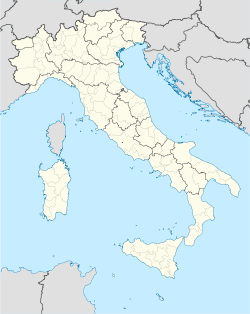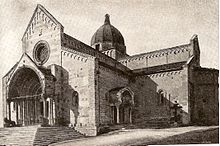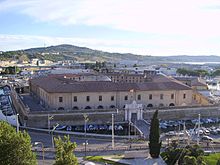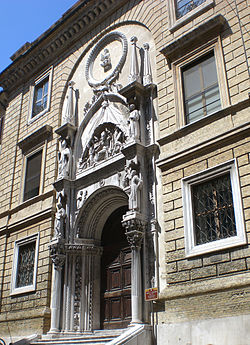- Ancona
-
This article is about the city in Italy. For other uses, see Ancona (disambiguation).
Ancona — Comune — Città di Ancona Aerial view of Ancona 
Coat of armsLocation of Ancona in Italy Coordinates: 43°37′01″N 13°31′00″E / 43.61694°N 13.5166667°ECoordinates: 43°37′01″N 13°31′00″E / 43.61694°N 13.5166667°E Country Italy Region Marche Province Ancona (AN) Frazioni Aspio, Gallignano, Montacuto, Massignano, Montesicuro, Candia, Ghettarello, Paterno, Casine di Paterno, Poggio di Ancona, Sappanico, Varano Government – Mayor Fiorello Gramillano (Democratic Party) Area – Total 123.71 km2 (47.8 sq mi) Elevation 16 m (52 ft) Population (31 August 2007) – Total 101,210 – Density 818.1/km2 (2,118.9/sq mi) Demonym Anconetani, Anconitani (English: anconitans) Time zone CET (UTC+1) – Summer (DST) CEST (UTC+2) Postal code 60100, from 60121 to 60129, 60131 Dialing code 071 Patron saint Judas Cyriacus Saint day 4 May Website Official website Ancona ([aŋˈkoːna] (
 listen), from Greek: Ἀγκών - Ankon) is a city and a seaport in the Marche region, in central Italy, with a population of 101,909 (2005). Ancona is the capital of the province of Ancona and of the region.
listen), from Greek: Ἀγκών - Ankon) is a city and a seaport in the Marche region, in central Italy, with a population of 101,909 (2005). Ancona is the capital of the province of Ancona and of the region.The city is located 280 km (170 mi) northeast of Rome, on the Adriatic Sea, between the slopes of the two extremities of the promontory of Monte Conero, Monte Astagno and Monte Guasco.
Ancona is one of the main ports on the Adriatic Sea, especially for passenger traffic, and is the main economic and demographic center of the region.
Contents
History
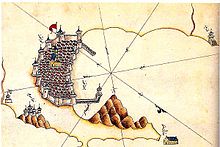 Historic map of Ancona by Piri Reis.
Historic map of Ancona by Piri Reis.
Ancona was founded by Greek settlers from Syracuse about 387 BC, who gave it its name: Ancona is a very slightly modified transliteration of the Greek Αγκων, meaning "elbow"; the harbor to the east of the town was originally protected only by the promontory on the north, shaped like an elbow. Greek merchants established a Tyrian purple dye factory here.[1] In Roman times it kept its own coinage with the punning device of the bent arm holding a palm branch, and the head of Aphrodite on the reverse, and continued the use of the Greek language.
When it became a Roman colony is doubtful. It was occupied as a naval station in the Illyrian War of 178 BC.[2] Julius Caesar took possession of it immediately after crossing the Rubicon. Its harbour was of considerable importance in imperial times, as the nearest to Dalmatia, and was enlarged by Trajan, who constructed the north quay with his Syrian architect Apollodorus of Damascus. At the beginning of it stands the marble triumphal arch with a single archway, and without bas-reliefs, erected in his honour in 115 by the Senate and Roman people.
After the fall of the Western Roman Empire, Ancona was successively attacked by the Goths, Lombards and Saracens, but recovered its strength and importance. It was one of the cities of the Pentapolis under the Exarchate of Ravenna, an administrative unit of the Byzantine Empire.[3] With the Carolingian conquest of northern Italy, it became the capital of the Marca di Ancona, whence the name of the modern region. After 1000, Ancona became increasingly independent, eventually turning into an important maritime republic (together with Gaeta, Trani and Ragusa, it is one of those not appearing on the Italian naval flag), often clashing against the nearby power of Venice. An oligarchic republic, Ancona was ruled by six Elders, elected by the three terzieri into which the city was divided: S. Pietro, Porto and Capodimonte. It had a coin of its own, the agontano, and a series of laws known as Statuti del mare e del Terzenale and Statuti della Dogana. Ancona was usually allied with Ragusa and the Byzantine Empire. In 1137, 1167 and 1174 it was strong enough to push back imperial forces. Anconitan ships took part in the Crusades, and their navigators included Cyriac of Ancona. In the struggle between the Popes and the Emperors that troubled Italy from the 12th century onwards, Ancona sided with the Guelphs.
Differently from other cities of northern Italy, Ancona never became a seignory. The sole exception was the rule of the Malatesta, who took the city in 1348 taking advantage of the black death and of a fire that had destroyed many of its important buildings. The Malatesta were ousted in 1383. In 1532 it definitively lost its freedom and became part of the Papal States, under Pope Clement VII. Symbol of the papal authority was the massive Citadel. Together with Rome and Avignon, Ancona was the sole city in the Papal States in which the Jews were allowed to stay after 1569, living in the ghetto built after 1555.
In 1733 Pope Clement XII extended the quay, and an inferior imitation of Trajan's arch was set up; he also erected a Lazaretto at the south end of the harbor, Luigi Vanvitelli being the architect-in-chief. The southern quay was built in 1880, and the harbour was protected by forts on the heights. From 1797 onwards, when the French took it, it frequently appears in history as an important fortress. Ancona entered in the Kingdom of Italy when Christophe Léon Louis Juchault de Lamoricière surrendered here on 29 September 1860, eleven days after his defeat at Castelfidardo.
During World War II, in July 1944, the city was taken by the Polish II Corps as part of an Allied operation to gain access to a seaport closer to the Gothic Line in order to shorten their lines of communication for the advance into northern Italy.
The Greek community of Ancona in the 16th century
Ancona, as well as Venice, became a very important destination for merchants from the Ottoman Empire during the 16th century. The Greeks formed the larger of the communities of the foreign merchants. They were refugees from former Byzantine or Venetian territories that were occupied by the Ottomans in the late 15th and 16th c. The first Greek community was established in Ancona early in the 16th c. Natalucci, the 17th c. historian of the city, notes the existence of 200 Greek families in Ancona at the opening of 16th c. Most of them came from northwestern Greece, i.e. the Ionian islands and Epirus. In 1514 Dimitri Caloiri of Ioannina obtained reduced custom duties for Greek merchants coming from the towns of Ioannina, Arta and Avlona in Epirus. In 1518 a Jewish merchant of Avlona succeeded in lowering the duties paid in Ancona for all “the Levantine merchants, subjects to the Turk”.
In 1531 the Confraternity of the Greeks (Confraternita dei Greci) was established which included Orthodox and Catholic Greeks. They secured the use of the Church of St. Anna dei Greci and were granted permission to hold services according to the Greek and the Latin rite. The church of St. Anna was existed since 13th c. initially as “Santa Maria in Porta Cipriana”, on ruins of the ancient Greek walls of Ancona.
In 1534 a decision by Pope Paul III favoured the activity of merchants of all nationalities and religions from the Levant and allowed them to settle in Ancona with their families. A Venetian travelling through Ancona in 1535 recorded that the city was “full of merchants from every nation and mostly Greeks and Turks”. In the second half of the 16th c. the presence of Greeks and other merchants from the Ottoman Empire declined after a series of restricion mesures taken by the Italian imperial authorities and the pope.
Disputes between the Orthodox and Catholic Greeks of the community were frequent and persisted till 1797 when the city was occupied by France who closed all the religious confraternities and confiscated the archive of the Greek community. The church of St. Anna dei Greci was re-opened to services in 1822. In 1835, in the absence of a Greek community in Ancona, it passed to the Latin Church.[4][5]
Demographics
Historical populations Year Pop. ±% 1174 11,000 — 1565 18,435 +67.6% 1582 27,770 +50.6% 1656 17,033 −38.7% 1701 16,212 −4.8% 1708 16,194 −0.1% 1769 23,028 +42.2% 1809 31,231 +35.6% 1816 32,636 +4.5% 1828 36,816 +12.8% 1844 43,217 +17.4% 1846 43,953 +1.7% 1853 44,833 +2.0% 1861 47,230 +5.3% 1871 45,681 −3.3% 1881 48,888 +7.0% 1901 58,602 +19.9% 1911 65,388 +11.6% 1921 68,521 +4.8% 1931 75,372 +10.0% 1936 78,639 +4.3% 1951 85,763 +9.1% 1961 100,485 +17.2% 1971 109,789 +9.3% 1981 106,432 −3.1% 1991 101,285 −4.8% 2001 100,507 −0.8% Source: P. Burattini. Stradario – Guida della città di Ancona (Ancona, 1951) and ISTAT In 2007, there were 101,480 people residing in Ancona (the greater area has a population more than four times its size), located in the province of Ancona, Marche, of whom 47.6% were male and 52.4% were female. Minors (children ages 18 and younger) totalled 15.54 percent of the population compared to pensioners who number 24.06 percent. This compares with the Italian average of 18.06 percent (minors) and 19.94 percent (pensioners). The average age of Ancona resident is 48 compared to the Italian average of 42. In the five years between 2002 and 2007, the population of Ancona grew by 1.48 percent, while Italy as a whole grew by 3.56 percent.[1][2] The current birth rate of Ancona is 8.14 births per 1,000 inhabitants compared to the Italian average of 9.45 births.
As of 2006, 92.77% of the population was Italian. The largest immigrant group came from other European nations (particularly those from Albania, Romania and Ukraine): 3.14%, followed by the Americas: 0.93%, East Asia: 0.83%, and North Africa: 0.80%.
Main sights
Cathedral church of S. Ciriaco
The Cathedral of Ancona, dedicated to Judas Cyriacus, was consecrated at the beginning of the 11th century and completed in 1189.[6] Some writers suppose that the original church was in the form of a basilica and belonged to the 7th century. An early restoration was completed in 1234. It is a fine Romanesque building in grey stone, built in the form of a Greek cross, and other elements of Byzantine art. It has a dodecagonal dome over the center slightly altered by Margaritone d'Arezzo in 1270. The façade has a Gothic portal, ascribed to Giorgio da Como (1228), which was intended to have a lateral arch on each side.
The interior, which has a crypt under each transept, in the main preserves its original character. It has ten columns which are attributed to the temple of Venus. The church was restored in the 1980s.
Other sights
- The marble Arch of Trajan, 18 m high, erected in 114/115 as an entrance to the causeway atop the harbor wall in honor of the emperor who had made the harbor, is one of the finest Roman monuments in the Marche. Most of its original bronze enrichments have disappeared. It stands on a high podium approached by a wide flight of steps. The archway, only 3 m wide, is flanked by pairs of fluted Corinthian columns on pedestals. An attic bears inscriptions. The format is that of the Arch of Titus in Rome, but made taller, so that the bronze figures surmounting it, of Trajan, his wife Plotina and sister Marciana, would figure as a landmark for ships approaching Rome's greatest Adriatic port.
- The Lazzaretto (Laemocomium or "Mole Vanvitelliana"), planned by architect Luigi Vanvitelli in 1732 is a pentagonal building covering more than 20,000 m², built to protect the military defensive authorities from the risk of contagious diseases eventually reaching the town with the ships. Later it was used also as a military hospital or as barracks; it is currently used for cultural exhibits.
- The Episcopal Palace was the place where Pope Pius II died in 1464.
- The church of Santa Maria della Piazza, with an elaborate arcaded façade (1210).
- The Palazzo del Comune, with its lofty arched substructures at the back, was the work of Margaritone d'Arezzo, but has been restored twice.
- Church of San Francesco alle Scale
- Church of Sant'Agostino, built by the Augustinians in 1341 as Santa Maria del Popolo, and enlarged by Luigi Vanvitelli in the 18th century and turned into a palace after 1860. It has maintained the Gothic portal by Giorgio da Sebenico, with statues portraying St. Monica, St. Nicola da Tolentino, St. Simplicianus and Blessed Agostino Trionfi.
- Church of the Santi Pellegrino e Teresa (18th century)
- Church of the Santissimo Sacramento (16th and 18th century)
There are also several fine late Gothic buildings, including the Palazzo Benincasa, the Palazzo del Senato and the Loggia dei Mercanti, all by Giorgio da Sebenico, and the prefecture, which has Renaissance additions.
The archaeological museum contains pre-Roman (Piceni) objects from tombs in the district, and two Roman beds with fine decorations in ivory.
The Pinacoteca Civica Francesco Podesti is housed in the Palazzo Bosdari, reconstructed in 1558 - 1561 by Pellegrino Tibaldi. Works in the gallery include:
- Madonna with Child, panel by Carlo Crivelli
- Sacra Conversazione by Lorenzo Lotto
- Portrait of Francesco Arsilli by Sebastiano Del Piombo
- Circumcision by Orazio Gentileschi
- Immaculate Conception and St. Palazia by Guercino
- Four Saints in Ecstasis and Musician Angels by Andrea Lillio
- Gozzi Altarpiece by Titian
Other artists present include Carlo da Camerino (late 15th- early 16th century) and Arcangelo di Cola (fl. 1416-1429). Modern artists featured are Bartolini, Bucci, Campigli, Cassinari, Cucchi, Levi, Sassu, Tamburi, Trubbiani, Podesti and others.
Angelo Messi, ancestor of famous football star Lionel Messi emigrated from Ancona to Rosario, Argentina in the 1880s.
Transportation
Shipping
The Port has regular ferry links to the following cities with the following operators:
- Adria Ferries (Durrës)
- Blue Line International (Split, Stari Grad, Vis)
- Jadrolinija (Split, Zadar)
- SNAV (Split) (seasonal)
- Superfast Ferries (Igoumenitsa, Patras)
- ANEK Lines (Igoumenitsa, Patras)
- Minoan Lines (Igoumenitsa, Patras)
- Marmara Lines (Cesme)
Airport
Ancona is served by Ancona Airport (IATA: AOI, ICAO: LIPY), an airport located in Falconara Marittima and named after Raffaello Sanzio.
Railways
Ancona "Centrale" is the main railway station of the city and is served by regional and long distance trains. The other stations are Ancona Marittima, Ancona Torrette, Palombina and Varano.
Roads
The A14 motorway serves the city with the exits "Ancona Nord" (An. North) and "Ancona Sud" (An. South).
Urban public transportation
The Ancona trolleybus system has been in operation since 1949. Ancona is also served by an urban bus network.
International relations
See also: List of twin towns and sister cities in ItalyTwin towns – Sister cities
Ancona is twinned with:
See also
- Maritime republics
- Biblioteca comunale Luciano Benincasa
Notes
- ^ Silius Italicus, VIII. 438
- ^ Livy xli. i
- ^ The other four were Fano, Pesaro, Senigallia and Rimini
- ^ Greene Molly (2010) Catholic pirates and Greek merchants: a maritime history of the Mediterranean. Princeton University Press, Britain, pp. 15-51.
- ^ Rentetzi Efthalia (2007) La chiesa di Sant' Anna dei Greci di Ancona. Thesaurismata (Instituto Ellenico di Studi Bizantini e Postbizantini di Venezia), vol. 37.
- ^ San Ciriaco - La cattedrale di Ancona, Federico Motta editore, 2003
References
Notes
 This article incorporates text from a publication now in the public domain: Chisholm, Hugh, ed (1911). Encyclopædia Britannica (11th ed.). Cambridge University Press.
This article incorporates text from a publication now in the public domain: Chisholm, Hugh, ed (1911). Encyclopædia Britannica (11th ed.). Cambridge University Press.
External links
- Official Site
- Marche Tourism site
- Photos: sauromarini.it, antoniomucherino.it
- Ancona, a breed of chicken named after the Italian city
- Site with photo, guides and forum
- Wine and Fish in the city of Ancona
- The Jewish Community of Ancona
- A little English Guide website made from the people of Ancona, to show Another point of view
Marche · Comuni of the Province of Ancona Agugliano · Ancona · Arcevia · Barbara · Belvedere Ostrense · Camerano · Camerata Picena · Castel Colonna · Castelbellino · Castelfidardo · Castelleone di Suasa · Castelplanio · Cerreto d'Esi · Chiaravalle · Corinaldo · Cupramontana · Fabriano · Falconara Marittima · Filottrano · Genga · Iesi · Loreto · Maiolati Spontini · Mergo · Monsano · Monte Roberto · Monte San Vito · Montecarotto · Montemarciano · Monterado · Morro d'Alba · Numana · Offagna · Osimo · Ostra · Ostra Vetere · Poggio San Marcello · Polverigi · Ripe · Rosora · San Marcello · San Paolo di Jesi · Santa Maria Nuova · Sassoferrato · Senigallia · Serra San Quirico · Serra de' Conti · Sirolo · StaffoloRegional capitals of Italy Maritime republics  Categories:
Categories:- Cities and towns in the Marche
- Communes of the Province of Ancona
- Ancona
- Coastal cities and towns in Italy
- Populated places established in the 4th century BC
- Maritime Republics
- Port cities and towns of the Adriatic Sea
- Mediterranean port cities and towns in Italy
- Ancient Greek cities
Wikimedia Foundation. 2010.


